400-998-5282
专注多肽 服务科研
400-998-5282
专注多肽 服务科研
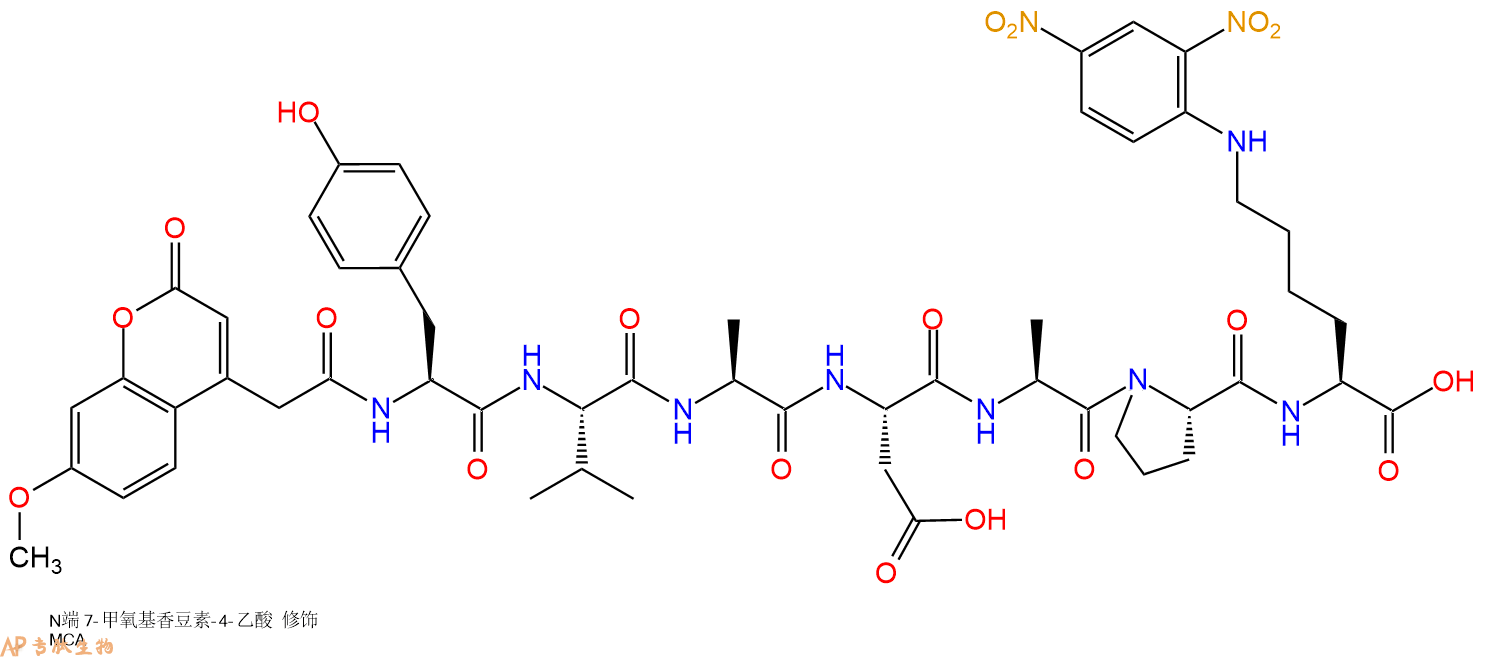
用于测定胱天蛋白酶-1(ICE)和胱天蛋白酶1样酶活性的特异性高荧光FRET底物。
编号:193106
CAS号:189696-01-3
单字母:Mca-YVADAP-K(Dnp)-OH
| 编号: | 193106 |
| 中文名称: | 七肽Mca-YVADAP-K(Dnp) |
| 英文名: | Mca- YVADAPK(Dnp) |
| CAS号: | 189696-01-3 |
| 单字母: | Mca-YVADAP-K(Dnp)-OH |
| 三字母: | MCA (7-甲氧基香豆素-4-基)乙酰基 MCA是一种荧光染料,其激发波长为325纳米,发射波长为392纳米。 -TyrL-酪氨酸:tyrosine。系统命名为(2S)-氨基-3-(4-羟基苯基)丙酸。是编码氨基酸。符号:Y,Tyr。 -ValL-缬氨酸:valine。系统命名为(2S)-氨基-3-甲基丁酸。是编码氨基酸。是哺乳动物的必需氨基酸。符号:V,Val。在某些放线菌素如缬霉素中存在 D-缬氨酸。 -Ala丙氨酸:alanine。L-丙氨酸的系统命名为(2S)-氨基丙酸,是编码氨基酸,也叫L-α-丙氨酸。符号:A,Ala。D-丙氨酸存在于多种细菌细胞壁的糖肽中。β-丙氨酸是维生素泛酸和辅酶A的组分。 -AspL-天冬氨酸:aspartic acid。系统命名为(2S)-氨基-丁二酸。是编码氨基酸,又是神经递质。符号:D,Asp。D-天冬氨酸存在于多种细菌的细胞壁和短杆菌肽A中。 -Ala丙氨酸:alanine。L-丙氨酸的系统命名为(2S)-氨基丙酸,是编码氨基酸,也叫L-α-丙氨酸。符号:A,Ala。D-丙氨酸存在于多种细菌细胞壁的糖肽中。β-丙氨酸是维生素泛酸和辅酶A的组分。 -ProL-脯氨酸:proline。系统命名为吡咯烷-(2S)-羧酸。为亚氨基酸。是编码氨基酸。在肽链中有特殊作用,如易形成顺式的肽键等。符号:P,Pro。 -Lys(Dnp)侧链Dnp保护的赖氨酸 -OHC端羧基:C-terminal carboxyl group。在肽或多肽链中含有游离羧基的氨基酸一端。在表示氨基酸序列时,通常将C端放在肽链的右边。 |
| 氨基酸个数: | 7 |
| 分子式: | C53H64O19N10 |
| 平均分子量: | 1145.13 |
| 精确分子量: | 1144.43 |
| 等电点(PI): | 7.01 |
| pH=7.0时的净电荷数: | - |
| 平均亲水性: | -0.58 |
| 疏水性值: | 0.3 |
| 外观与性状: | 白色粉末状固体 |
| 消光系数: | 1490 |
| 来源: | 人工化学合成,仅限科学研究使用,不得用于人体。 |
| 纯度: | 95%、98% |
| 盐体系: | 可选TFA、HAc、HCl |
| 储存条件: | 负80℃至负20℃ |
| 标签: | 侧链保护基肽 MCA标记肽 |
Specific highly fluorescent FRET substrate for the determination of caspase-1 (ICE) and caspase-1-like enzyme activities. Cleavage of Mca-YVADAPK(Dnp) at the P1 Asp residue results in a continuous fluorescent assay monitored at an emission wavelength of 392 nm. Caspase-3 (apopain, CPP-32) is only weakly active on this substrate. Both caspase-1 and caspase-3 are involved in apoptosis. A specific substrate for renal ACE 2.
MCA标记肽的说明
(7-Methoxycoumarin-4-yl)acetyl is fluorophor with an excitation at 325 nm ▉ and emission of 392 nm ▉.
MCA标记肽相关文献:
Characterization of the Altai Maral Chymosin Gene, Production of a Chymosin Recombinant Analog in the Prokaryotic Expression System, and Analysis of Its Several Biochemical Properties.
Belenkaya, S. V., A. A. Bondar, T. A. Kurgina, V. V. Elchaninov, A. Yu Bakulina, E. A. Rukhlova, O. I. Lavrik, A. A. Ilyichev, and D. N. Shcherbakov. Biochemistry (Moscow), 2020.
IL-1b is an innate immune sensor of microbial proteolysis.
LaRock, Christopher N., et al. Science Immunology 100.200: 300 (2016).
| DOI | 名称 | |
|---|---|---|
| 10.1074/jbc.M200581200 | Hydrolysis of biological peptides by human angiotensin-converting enzyme-related carboxypeptidase | 下载 |
| 10.1186/2042-6410-1-6 | Sex differences in renal angiotensin converting enzyme 2 (ACE2) activity are 17β-oestradiol-dependent and sex chromosome-independent | 下载 |
| 10.1074/jbc.M112.380816 | Sizzled is unique among secreted frizzled-related proteins for its ability to specifically inhibit bone morphogenetic protein-1 (BMP-1)/tolloid-like proteinases | 下载 |
| 10.1038/380723a0 | Sequential activation of ICE-like and CPP32-like proteases during Fas-mediated apoptosis | 下载 |
| 10.1074/jbc.M109.086447 | Role of the netrin-like domain of procollagen C-proteinase enhancer-1 in the control of metalloproteinase activity | 下载 |
多肽MCA-Tyr-Val-Ala-Asp-Ala-Pro-Lys(Dnp)-COOH的合成步骤:
1、合成CTC树脂:称取1.17g CTC Resin(如初始取代度约为1.17mmol/g)和1.64mmol Fmoc-Lys(Dnp)-OH于反应器中,加入适量DCM溶解氨基酸(需要注意,此时CTC树脂体积会增大好几倍,避免DCM溶液过少),再加入4.11mmol DIPEA(Mw:129.1,d:0.740g/ml),反应2-3小时后,可不抽滤溶液,直接加入1ml的HPLC级甲醇,封端半小时。依次用DMF洗涤2次,甲醇洗涤1次,DCM洗涤一次,甲醇洗涤一次,DCM洗涤一次,DMF洗涤2次(这里使用甲醇和DCM交替洗涤,是为了更好地去除其他溶质,有利于后续反应)。得到 Fmoc-Lys(Dnp)-CTC Resin。结构图如下:
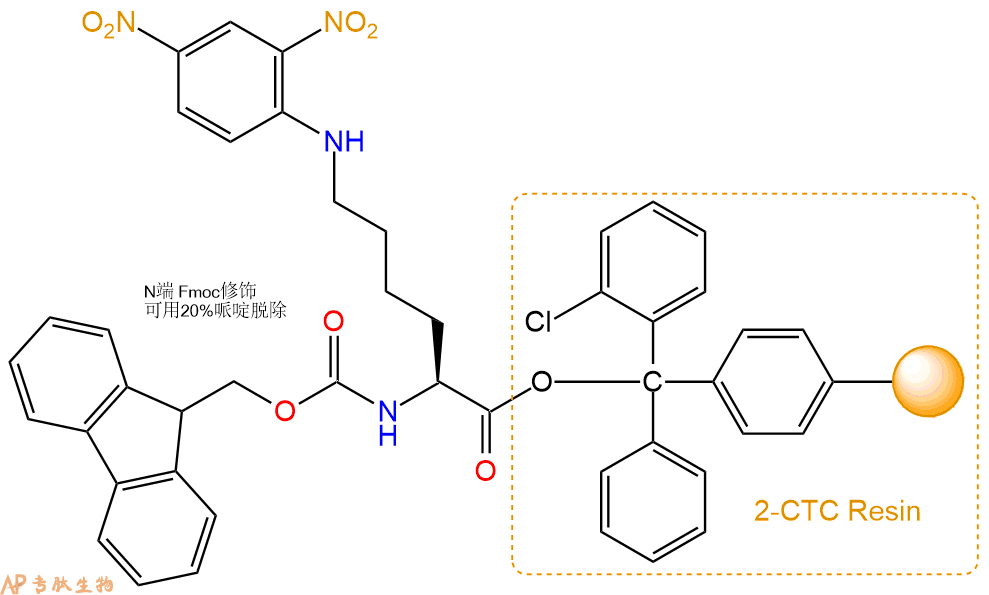
2、脱Fmoc:加3倍树脂体积的20%Pip/DMF溶液,鼓氮气30分钟,然后2倍树脂体积的DMF 洗涤5次。得到 H2N-Lys(Dnp)-CTC Resin 。(此步骤脱除Fmoc基团,茚三酮检测为蓝色,Pip为哌啶)。结构图如下:
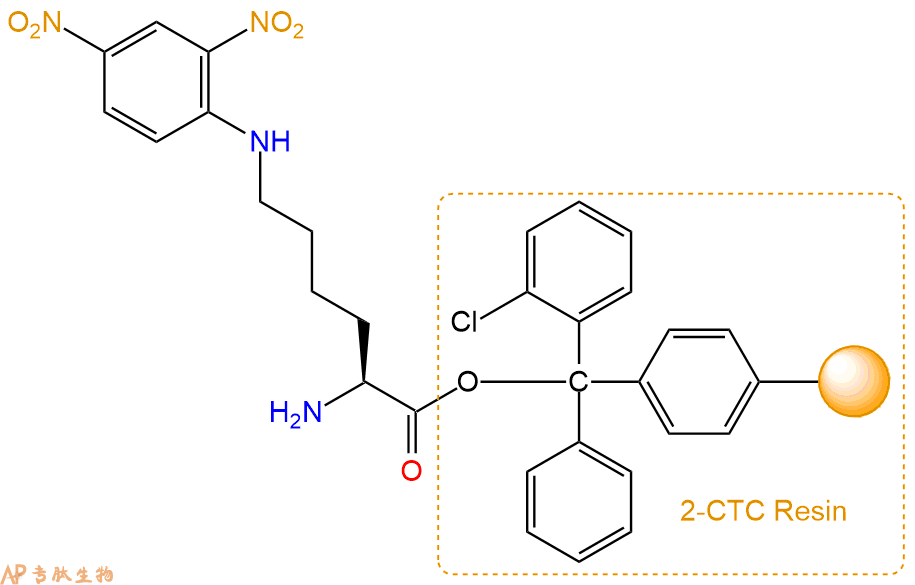
3、缩合:取4.11mmol Fmoc-Pro-OH 氨基酸,加入到上述树脂里,加适当DMF溶解氨基酸,再依次加入8.21mmol DIPEA,3.9mmol HBTU。反应30分钟后,取小样洗涤,茚三酮检测为无色。用2倍树脂体积的DMF 洗涤3次树脂。(洗涤树脂,去掉残留溶剂,为下一步反应做准备)。得到Fmoc-Pro-Lys(Dnp)-CTC Resin。氨基酸:DIPEA:HBTU:树脂=3:6:2.85:1(摩尔比)。结构图如下:
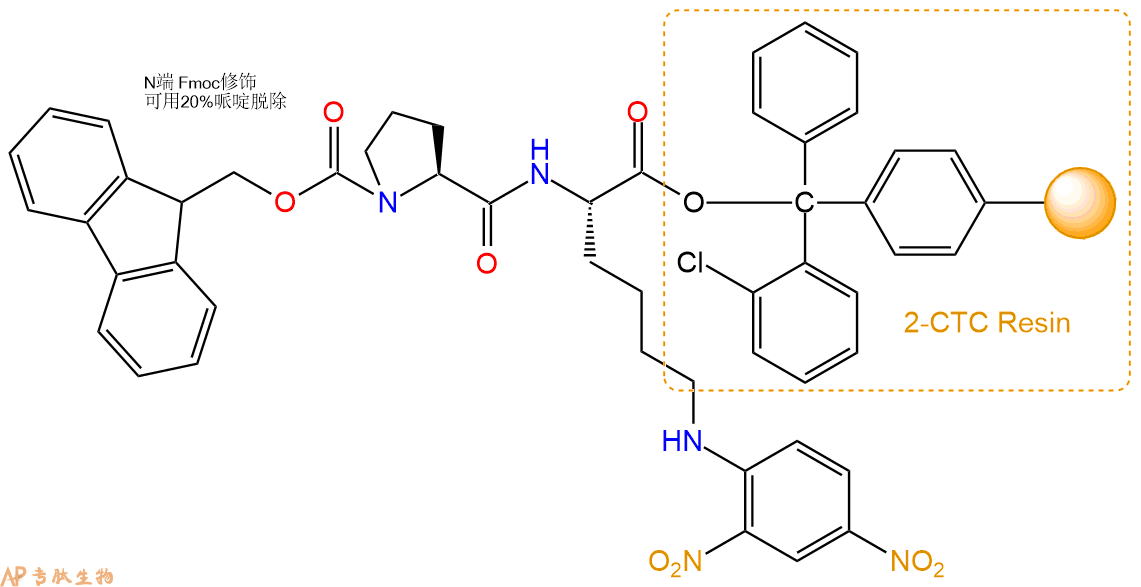
4、依次循环步骤二、步骤三,依次得到
H2N-Pro-Lys(Dnp)-CTC Resin
Fmoc-Ala-Pro-Lys(Dnp)-CTC Resin
H2N-Ala-Pro-Lys(Dnp)-CTC Resin
Fmoc-Asp(OtBu)-Ala-Pro-Lys(Dnp)-CTC Resin
H2N-Asp(OtBu)-Ala-Pro-Lys(Dnp)-CTC Resin
Fmoc-Ala-Asp(OtBu)-Ala-Pro-Lys(Dnp)-CTC Resin
H2N-Ala-Asp(OtBu)-Ala-Pro-Lys(Dnp)-CTC Resin
Fmoc-Val-Ala-Asp(OtBu)-Ala-Pro-Lys(Dnp)-CTC Resin
H2N-Val-Ala-Asp(OtBu)-Ala-Pro-Lys(Dnp)-CTC Resin
Fmoc-Tyr(tBu)-Val-Ala-Asp(OtBu)-Ala-Pro-Lys(Dnp)-CTC Resin
以上中间结构,均可在专肽生物多肽计算器-多肽结构计算器中,一键画出。
最后再经过步骤二得到 H2N-Tyr(tBu)-Val-Ala-Asp(OtBu)-Ala-Pro-Lys(Dnp)-CTC Resin,结构如下:
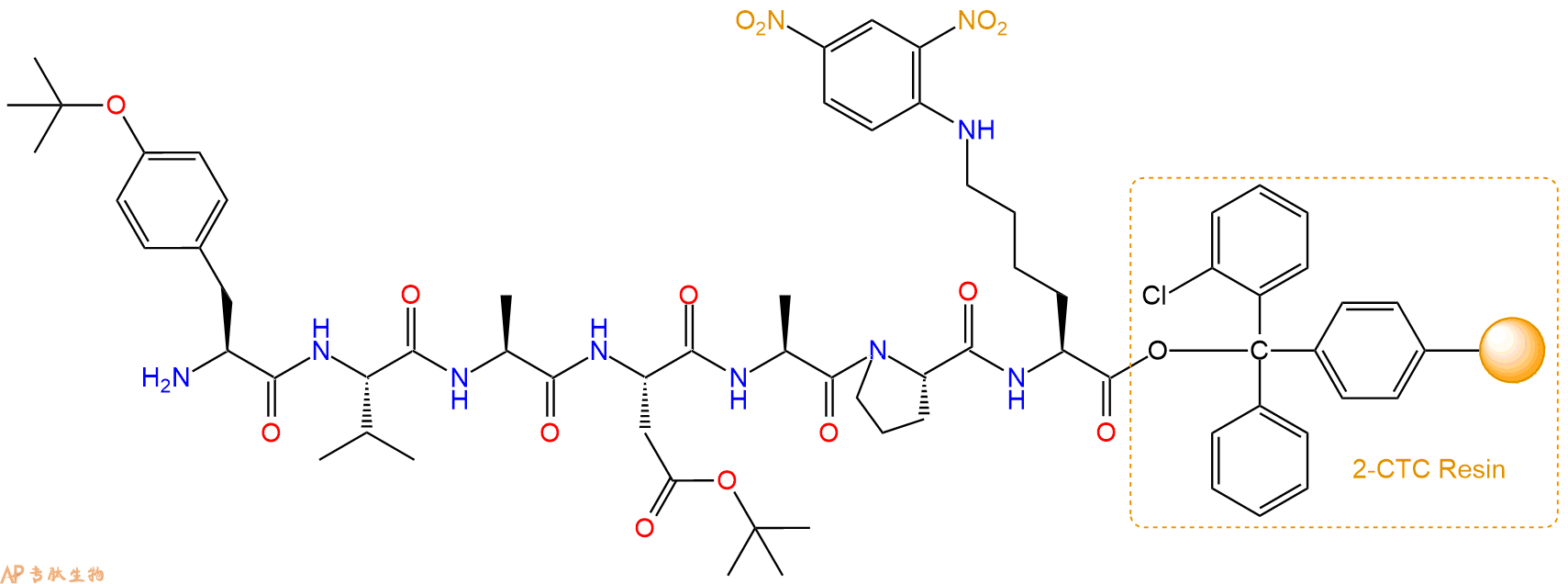
5、7-甲氧基香豆素-4-乙酸(MCA)反应连接:在上述树脂中,加入适当DMF后,再加入4.11mmol 7-甲氧基香豆素-4-乙酸(MCA)到树脂中,再加入8.21mmol DIPEA、3.9mmol HBTU,鼓氮气反应30分钟。用2倍树脂体积的DMF 洗涤3次树脂(洗涤树脂,去掉残留溶剂,为下一步反应做准备)。 得到MCA-Tyr(tBu)-Val-Ala-Asp(OtBu)-Ala-Pro-Lys(Dnp)-CTCResin。 结构如下:

6、切割:6倍树脂体积的切割液(或每1g树脂加8ml左右的切割液),摇床摇晃 2小时,过滤掉树脂,用冰无水乙醚沉淀滤液,并用冰无水乙醚洗涤沉淀物3次,最后将沉淀物放真空干燥釜中,常温干燥24小试,得到粗品MCA-Tyr-Val-Ala-Asp-Ala-Pro-Lys(Dnp)-COOH。结构图见产品结构图。
切割液选择:1)TFA:H2O=95%:5%
2)TFA:H2O:TIS=95%:2.5%:2.5%
3)三氟乙酸:茴香硫醚:1,2-乙二硫醇:苯酚:水=87.5%:5%:2.5%:2.5%:2.5%
(前两种适合没有容易氧化的氨基酸,例如Trp、Cys、Met。第三种适合几乎所有的序列。)
6、纯化冻干:使用液相色谱纯化,收集目标峰液体,进行冻干,获得蓬松的粉末状固体多肽。不过这时要取小样复测下纯度 是否目标纯度。
7、最后总结:
杭州专肽生物技术有限公司(ALLPEPTIDE https://www.allpeptide.com)主营定制多肽合成业务,提供各类长肽,短肽,环肽,提供各类修饰肽,如:荧光标记修饰(CY3、CY5、CY5.5、CY7、FAM、FITC、Rhodamine B、TAMRA等),功能基团修饰肽(叠氮、炔基、DBCO、DOTA、NOTA等),同位素标记肽(N15、C13),订书肽(Stapled Peptide),脂肪酸修饰肽(Pal、Myr、Ste),磷酸化修饰肽(P-Ser、P-Thr、P-Tyr),环肽(酰胺键环肽、一对或者多对二硫键环),生物素标记肽,PEG修饰肽,甲基化修饰肽
以上所有内容,为专肽生物原创内容,请勿发布到其他网站上。





